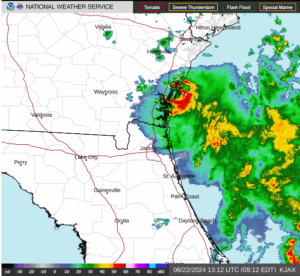A fast moving tropical wave was over the eastern Caribbean Sea on Tuesday afternoon. The wave has been designated as Invest 94L. At 2:00 p.m. EDT on Tuesday the center of the tropical wave located at latitude 12.2°N and longitude 65.7°W which put the center about 170 miles (275 km) east of Bonaire. The tropical wave was moving toward the west at 25 m.p.h. (40 km/h). The maximum sustained wind speed was 30 m.p.h. (50 km/h) and there were wind gusts to 40 m.p.h. (65 km/h). The minimum surface pressure was 1010 mb.
A tropical wave moving rapidly over the eastern Caribbean Sea was designated as Invest 94L on Tuesday afternoon. The tropical wave did not have a well defined low level center of circulation. There did appear to be an area of rotation in the middle troposphere that was associated with the tropical wave. Lines of showers and thunderstorms were moving toward the west with the tropical wave.
The tropical wave designated as Invest 94L will move south of a high pressure system over the western Atlantic Ocean. The high pressure system will steer the tropical wave quickly toward the west during the next 24 hours. On its anticipated track, Invest 94L will pass over Bonaire, Curacao and Aruba during the next 24 hours. The tropical wave will bring thunderstorms and gusty winds to Bonaire, Curacao and Aruba.
The tropical wave designated as Invest 94L will move through an environment unfavorable for intensification during the next 24 hours. The tropical wave will move over water where the Sea Surface Temperatures are near 29°C. Invest 94L will move under the southern part of an upper level ridge over the Caribbean Sea. The upper level ridge will produce easterly winds that will blow toward the top of the tropical wave. Stronger easterly winds will blow in the lower levels of the atmosphere. The difference in wind speed between the upper and lower levels will cause moderate vertical wind shear. The wind shear will inhibit the formation of a tropical cyclone during the next 24 hours.
Invest 94L will move into an area where the lower level winds will be weaker when it reaches the western Caribbean Sea later this week. The vertical wind shear is likely to decrease when the tropical wave is over the western Caribbean Sea. The tropical wave could develop into a tropical cyclone later this week. The U.S. National Hurricane Center is indicating the probability is 20% that the tropical wave develops into a tropical cyclone when it reaches the western Caribbean Sea.

